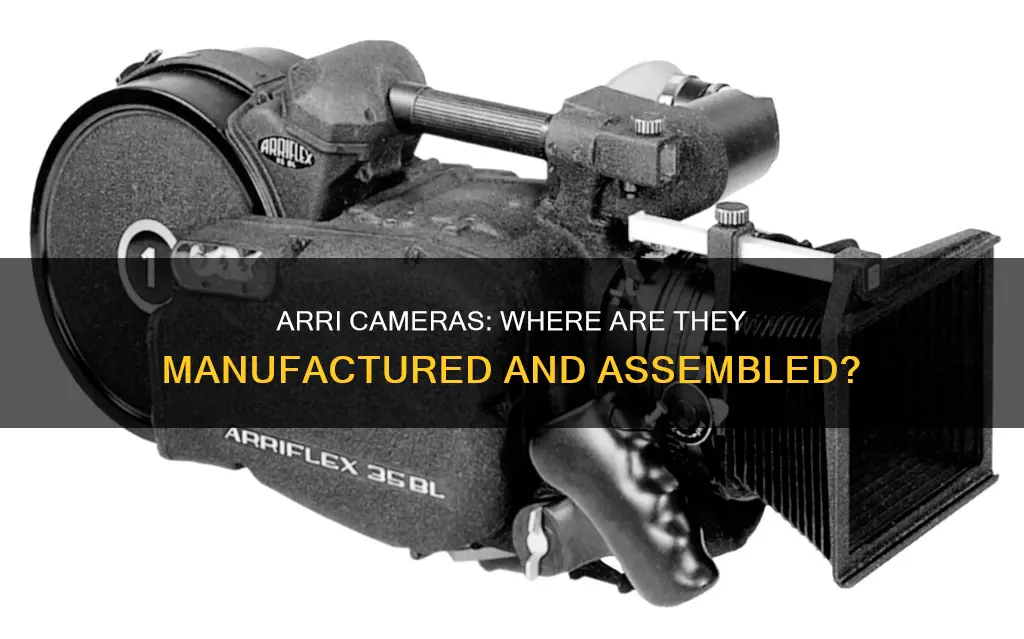
ARRI cameras are manufactured by the German company ARRI, which was founded in 1917. The company has a long history in the movie-making world and has been involved in countless award-winning films over the years. The ARRI Alexa, introduced in 2010, marked the company's first major transition into digital cinematography. ARRI cameras are known for their exceptional image quality and warm, organic look. The company often serves as the go-to option for high-end, big-budget productions.
| Characteristics | Values |
|---|---|
| Year founded | 1917 |
| First camera | Arriflex 35 |
| First camera release year | 1937 |
| Camera sensor manufacturer | ON Semiconductor |
| Camera sensor type | CMOS |
| Camera sensor size | 27.99 x 19.22 mm |
| Camera sensor resolution | 4608 x 3164 |
| Camera dynamic range | 17 stops |
| Camera system features | Modular design, PL mount lenses, Super 35-sized sensor, uncompressed video, proprietary raw codec |
| Camera recording media | SxS cards, CFast 2.0 cards, SXR Capture Drives, Codex Compact Drives |
| Camera recording resolution | Up to 3424 x 2202 pixels |
| Camera recording formats | Rec. 709 HD video, Log-C, ProRes, ArriRaw, DNxHD, Apple ProRes |
| Camera frame rate | Up to 120 fps |
| Camera price range | $50,000 to $100,000+ |
What You'll Learn

ARRI cameras are made in Germany
ARRI cameras are renowned for their exceptional image quality, dynamic range, and colour reproduction. The Alexa series, for example, features a proprietary sensor that delivers a broad dynamic range, capturing detailed images in a variety of lighting conditions. ARRI cameras are often the go-to choice for high-end, big-budget productions, with filmmakers renting these high-end cameras for each production.
The company's long-standing partnership with onsemi (formerly ON Semiconductor), an American manufacturer of semiconductor chips, has been integral to the development of ARRI's digital cinema cameras. onsemi's cutting-edge technologies have optimised pixel response and pixel readout for both HDR and high-frame-rate capture, enhancing the image quality of ARRI cameras.
ARRI's commitment to connecting creativity and future technologies has solidified its place as a leader in the global entertainment industry. The company provides state-of-the-art camera systems, lenses, lighting solutions, rental services, virtual production resources, and broadcast solutions. With a rich history of innovation and a dedication to pushing the boundaries of imaging technology, ARRI continues to inspire and empower creators around the world.
Charging Your 4K Ultra HD Camera: A Step-by-Step Guide
You may want to see also

The Alexa 35 is ARRI's latest flagship camera
ARRI has been a leading name in the camera industry for a long time. At the 77th Festival de Cannes, more than 80% of films in leading categories were captured using ARRI camera systems, with the ALEXA 35 being the most popular. The ALEXA 35 is ARRI's latest flagship camera and is considered the gold standard for digital cinematography.
The ALEXA 35 is a Super35-format camera with a 4:3 4.6K sensor that delivers 17 stops of dynamic range, which is 2.5 stops greater than previous ARRI cameras. This extra dynamic range gives cinematographers more control over their artistic intent, allowing them to capture both the darkest shadows and the brightest highlights with ease. The camera's low-light capabilities, rich colors, and new texture options make it an incredible tool for breathing life into stories.
The ALEXA 35 also offers versatile lens choices, with compatibility for a wide array of modern and vintage lenses in spherical, anamorphic, Super35, and large format options. The camera features five interchangeable lens mounts, including an LPL mount and a PL-to-LPL adapter.
In terms of recording formats, the ALEXA 35 provides a robust array of 19 or 20 ARRIRAW and Apple ProRes recording formats, allowing cinematographers to optimize data rate, resolution, and other parameters based on their specific needs. The camera supports frame rates of up to 120 fps and offers both MFX/ARRIRAW and MFX/Apple ProRes capture to 1 or 2TB Codex drives.
The ALEXA 35 is compact and easy to operate, with a simple menu structure and familiar features for camera assistants and operators. It includes a left-side display, making it ideal for stabilizer, drone, and crane use, as well as independent SDI outputs, audio inputs, and motorized ND filters.
The camera also has dedicated accessories available, such as mechanical and electronic support options, and can be powered by the ARRI B-Mount battery adapter, which is included in the Lightweight Set. Overall, the ALEXA 35 is an exceptional camera that raises the bar for digital cinema capture.
The Evolution of Retina Eye Camera Technology
You may want to see also

The Alexa 35's sensor was co-developed with onsemi
ARRI cameras are a popular choice for filmmakers, with over 80% of films in leading categories at the 77th Festival de Cannes captured using ARRI camera systems. The ALEXA 35, ARRI's newest digital cinema camera, features a cutting-edge sensor co-developed with onsemi, a leading semiconductor manufacturer. This sensor is the culmination of a 22-year partnership between the two companies, which began with the development of the ARRIFLEX D-20's CMOS sensor in 2005.
The ALEXA 35's sensor is a 4.6K Super 35 CMOS image sensor, capable of delivering a resolution of 4608x3164 pixels (14.6 megapixels) and a maximum frame rate of 120fps. It utilises onsemi's advanced technologies for optimising pixel response and readout, enhancing both HDR and high-frame-rate capture. The sensor's dynamic range of 15.1 stops at a signal-to-noise ratio of 2 sets a new record, surpassing its predecessors.
To accommodate the sensor's full capabilities, ARRI incorporated 18-bit internal processing and developed the REVEAL image processing pipeline, which includes a new LogC4 gamma curve to manage the sensor's expansive dynamic range. This ensures that filmmakers can capture exquisite visuals with unparalleled detail and colour accuracy.
The collaboration between ARRI and onsemi is a testament to their shared commitment to delivering exceptional image quality to the cinematography industry. Walter Trauninger, Managing Director and Head of Business Unit Camera Systems at ARRI, emphasised the significance of their long-term partnership, stating that it is the foundation for ARRI's ability to provide unparalleled image quality to filmmakers. The ARRI ALEXA camera system, equipped with onsemi's CMOS sensor, received prestigious accolades in 2017, including a Scientific and Engineering Award from the Academy of Motion Pictures Arts and Sciences and an Engineering Emmy from the Television Academy.
The ALEXA 35 continues the legacy of this successful collaboration, elevating digital cinematography to new heights. During the 75th Cannes Film Festival in 2022, 30 out of 49 films showcased, including the Palme d'Or winner "Triangle of Sadness," relied on cameras from the ARRI ALEXA family, all powered by onsemi's customised CMOS image sensors. This reinforces the trust that filmmakers have in the exceptional image quality delivered by the ARRI-onsemi partnership.
Updating Adobe Camera Raw CS6: A Step-by-Step Guide
You may want to see also

The Alexa camera system introduced Log-C imaging science
ARRI is a well-known name in the camera industry, and its Alexa camera system is widely used in the film industry. The Alexa camera system introduced Log-C imaging science, which offers several benefits for filmmakers.
Log-C imaging science serves as a digital negative, allowing digital cinema images to be processed like scanned film images. This means that cinematographers can manipulate images in post-production to achieve their desired aesthetic. The Log-C curve is a logarithmic encoding for images, with a grayscale characteristic similar to a scan from a negative film. This encoding ensures that each stop of exposure increases the signal by the same amount, providing a linear relationship between exposure and the encoded signal.
The Log-C encoding is based on the density of color film negatives, and images encoded with Log-C have a flat and desaturated nature. The whites and blacks are not extended to their maximum values. The reason for this is that the encoding has a logarithmic curve, which is designed to capture the full range of the chip's sensitivity. This allows for an extreme range of color correction options in post-production.
The Alexa camera system offers several methods of recording, including SxS cards, CFast 2.0 cards, and SXR Capture Drives. It supports uncompressed video and proprietary raw (ArriRaw) codecs. The camera's CMOS Super-35mm sensor is rated at 2.8K and ISO 800, providing exceptional sensitivity. This sensitivity allows the camera to capture a wide dynamic range, with seven stops of overexposure and seven stops of underexposure.
The Alexa camera system also introduced the REVEAL Color Science, which includes hardware, firmware, and software features. REVEAL represents a redesign of the end-to-end image-processing pipeline, offering new features and improvements. With REVEAL, cinematographers have more choices in terms of image texture, as it introduces a new set of tools. The default option, 'K445', matches the image characteristics of other cameras in the Alexa family, while other options provide different amounts of grain-like noise and local contrast enhancement.
How Shooting Raw Impacts Your Camera's Performance
You may want to see also

ARRI cameras are used in Hollywood and on TV
ARRI cameras are a common sight in Hollywood and on TV. At the 77th Festival de Cannes, over 80% of films in leading categories were filmed with ARRI camera systems, with the ALEXA 35 and ALEXA Mini being the most popular. The ALEXA Mini LF and ALEXA 35 are also popular choices for filming comedy projects.
ARRI cameras are widely used in Hollywood because they produce high-quality images with excellent skin tones and colours that feel filmic. The cameras' sensors have a high dynamic range that is unrivalled by other cameras, with low noise that provides a pleasant, almost grain-like quality. ARRI cameras are also known for their durability and reliability, which makes them a popular choice for rental houses and filmmakers alike.
The company behind ARRI, the German manufacturer Arnold & Richter, has a long history in the film industry. Founded in 1917, ARRI has established itself as one of the best-known companies in the industry. The ARRI Alexa 65, for example, was used by Emmanuel Lubezki, a three-time Oscar-winning cinematographer, to film "The Revenant".
In addition to feature films, ARRI cameras are also used in television productions. For example, the ARRI ALEXA Mini LF and ARRI Signature Prime lenses were used in the comedy "Mr. Putifar's Wacky Plan". ARRI's live entertainment technology is also used in sports broadcasting, providing cinematic images and easy integration with third-party technology.
Dodge Charger GT: Reverse Camera Availability
You may want to see also
Frequently asked questions
ARRI cameras are made in Germany. The company was founded in 1917 and has been a staple in the movie-making world for over a century.
The price of an ARRI camera depends on the model and accessories. For example, in 2015, an ARRI Alexa XT cost approximately $66,000 to $100,000, depending on the accessories included. ARRI's entry-level models, like the Alexa Mini LF, start at around $50,000, while some of their top-of-the-line models can cost over $100,000.
ARRI cameras are renowned for their color science, skin tone reproduction, and reliability. They are often the go-to choice for high-end, big-budget productions and have been used in countless award-winning films. The Alexa 35, for example, was used to capture over 80% of the films in leading categories at the 77th Festival de Cannes.







